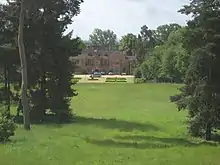The Vache
The Vache is an estate near Chalfont St Giles in Buckinghamshire, England. Located within the estate is a monument dedicated to the memory of Captain James Cook (1728–1779), the explorer. It has been owned or occupied by, among others, George Fleetwood, regicide of Charles I.[1]

History
The Vache was the family seat of the Fleetwoods. In 1660 George Fleetwood was found guilty of the regicide of King Charles, and although his life was spared, his estate of The Vache was confiscated and given to the then Duke of York, the future King James II.[2]
The Vache (then spelled Vatche) was part of the dowry of Mary Margaret Alston, who married Rev Dr Francis Hare at St Paul's Cathedral in 1728. The couple lived there, bringing up their seven children while the bishop wrote the books that made his name. He died in 1740 and was buried in a mausoleum in the local church. Their eldest son, Robert (named after Robert Walpole), had the Vache settled on him when he came of age; it is mentioned in his 1752 marriage settlement with Sarah Selman.[3] He became a Prebendary Canon of Winchester Cathedral, and, as he also owned Herstmonceux Castle, nearer to the city, he decided to sell the Vache in the 1770s.[4] The estate was acquired by Admiral Sir Hugh Palliser.[5] Following Palliser’s death in 1796, the building passed to his son and was then sold to Thomas Allen in 1826; the house passed down the Allen family until it was sold to James Robertson in 1902.[6]
After the Second World War, homelessness and overcrowding sparked a nationwide movement of squatting. One of the first of these occurred at The Vache in September 1946. The leader was an ex-Commando, John Mann, of Chalfont St. Giles, who had been sharing a small cottage with his wife, his five-year-old son, and ten strangers. At the local pub one night, Mann heard a Polish captain say that a deserted army camp at nearby Vache Park was being readied for Polish soldiers of General Władysław Anders's army in exile. Mann decided to get there first.[7] At dawn, he and a handful of homeless veterans bloodlessly routed three Polish guards and seized Vache Park. Next day, 120 families had moved into the spacious army huts. After a flurry of resistance, local authorities capitulated.[7]
Captain James Cook monument

The Vache is the site of a monument to Captain James Cook, erected by Admiral Sir Hugh Palliser.[8]
'To the memory of Captain James Cook/the ablest and most renowned Navigator this or any country hath produced', 'He raised himself solely by his merit/from a very obscure birth, to the rank/of a Post Captain in the Royal Navy,and/was unfortunately killed by the Savages/of the island Owhyee on the 14th of/February 1779 ...[8]
References
- David Plant,George Fleetwood, Regicide, bap.1623, the British Civil Wars and Commonwealth website
- Firth, C.H. (1889). . In Stephen, Leslie (ed.). Dictionary of National Biography. 19. London: Smith, Elder & Co. pp. 265–266.
- "Release and Settlement on the marriage of Robert Hare with Sarah Selman". The National Archives. 18 November 1752. Retrieved 7 July 2020.
- Hare, Augustus John Cuthbert (1877). Memorials of a Quiet Life (14th ed.). pp. 77–84.
- "The Cook Monument". Captain Cook Society. Retrieved 25 July 2017.
- "Parishes: Chalfont St. Giles, in A History of the County of Buckingham: Volume 3, ed. William Page". London. 1925. pp. 184–193. Retrieved 25 July 2017.
- "Squatters Camp at The Vache in 1946". Chalfont St Giles village website. 1 January 2015. Retrieved 31 March 2015.
- Memorial M1775, public memorials to seafarers and victims of maritime disaster, National Maritime Museum
